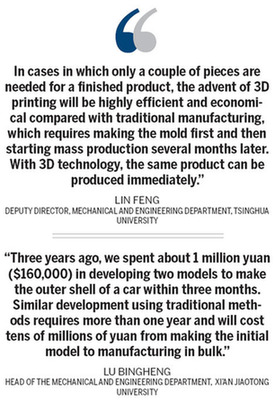3D printing reshapes manufacturing
Updated: 2013-02-18 09:34
By Wang Ying in Shanghai (China Daily)
|
||||||||
Admitting there is a gap in the application of 3D printing between China and abroad, Shi of Huazhong University of Science and Technology said the technology is widely used in product development in overseas markets including aerospace, medical treatment, innovation and education. Shi added there was little progress in such applications in China.
|
|
In terms of applications, the US accounts for 40 percent of the global market while China has less than 6 percent, said Xi'an Jiaotong University's Lu.
Experts say it has a lot to do with the lack of innovative design in China. "Most of the mass-produced products in China do not have a copyright so manufacturers just copy the models and make more of them," said Lu.
Lu said many manufacturing enterprises are plagued by overcapacity. One solution is to put more focus on developing innovative products.
"We see a growing trend in China toward additive manufacturing where, initially, applications in the medical field will benefit and be used. Furthermore, an increasing number of industrial research and development centers are moving to China. They will also start to make use of 3D printing," said Kim Francois, managing director of Materialise China.
Francois said she saw an unlimited amount of possibilities in the Chinese market but it will take some time until they will be fully developed and integrated into society (something that is still ongoing in the US and Europe).
Additive manufacturing turned out products valued at $1.7 billion in 2011. The industry is growing at an annual rate of up to 30 percent. It is estimated the industry will be valued at $6 billion by 2020, with China accounting for between 15 percent and 20 percent of it by then.
"This size of industry cannot be called large but, if more enterprises from various industries embrace 3D printing, there will be huge capacity to work on it," said Lu.
Lin from Tsinghua University said his team is working on developing 3D cell structure printing at the moment.
"The characteristics of a cell have a lot to do with its shape. If we can imitate the cell and tissue activity in the human body, we can research how human beings work and even the processes of diseases. We can then use these research results to select medicines and even to study cancerous cells, a major cause of serious disease in human beings," said Lin.
Lu, from Xi'an Jiaotong University, has a more ideal outlook regarding the future of 3D printing.
He and his team are currently trying to bring down the cost of 3D printers. He said within one year they will be able to lower the price by several thousand yuan.
"By doing this it will become possible for such facilities to be used by middle schools and even domestically. Cultivating creative and innovative thought among the young will mean a lot for the nation's future," Lu said.
Contact the writer at wang_ying@chinadaily.com.cn
Related readings
3-D printing set to become more mainstream
3D printing, China's new growth point
Big 3D picture unveiled before Single's Day

 Li Na on Time cover, makes influential 100 list
Li Na on Time cover, makes influential 100 list
 FBI releases photos of 2 Boston bombings suspects
FBI releases photos of 2 Boston bombings suspects
 World's wackiest hairstyles
World's wackiest hairstyles
 Sandstorms strike Northwest China
Sandstorms strike Northwest China
 Never-seen photos of Madonna on display
Never-seen photos of Madonna on display
 H7N9 outbreak linked to waterfowl migration
H7N9 outbreak linked to waterfowl migration
 Dozens feared dead in Texas plant blast
Dozens feared dead in Texas plant blast
 Venezuelan court rules out manual votes counting
Venezuelan court rules out manual votes counting
Most Viewed
Editor's Picks

|

|

|

|

|

|
Today's Top News
Boston bombing suspect reported cornered on boat
7.0-magnitude quake hits Sichuan
Cross-talk artist helps to spread the word
'Green' awareness levels drop in Beijing
Palace Museum spruces up
First couple on Time's list of most influential
H7N9 flu transmission studied
Trading channels 'need to broaden'
US Weekly

|

|








